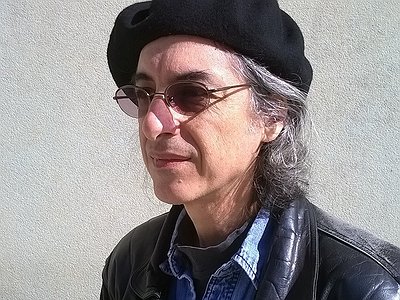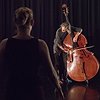Part 2
Could you take me through the process of composing on the basis of one of your pieces that's particularly dear to you, please? What do you start with when working on a new piece, for example, how do you form your creative decisions and how do you refine them?
I’m currently working on a composition for Communicating Vessels, a new group consisting of Dave Vosh on analogue modular synthesizer, Dani Seiss on flute and voice, Curt Seiss on real-time interactive electronics, and myself on double bass. The first decision I had to make with this piece—and the process is similar for other pieces I’ve composed—is to determine the overall architecture. Because of the makeup of the group, I thought a structure based on the Baroque sonata would be appropriate. The flute/voice and accompanying electronic deformations would be the lead voice, while the double bass and synth would form the continuo. The whole piece will be in one movement.
I imagine the analogue modular synth as a kind of contemporary harpsichord, setting out the underlying blocks of sound which function as the equivalent of a harmonic foundation. The synth—in good Baroque form—will improvise its part; Dave programs patches that self-generate relatively long-duration sounds that include an element of chance. For the flute, I’m devising a sound row—an ordered set of pitches and articulations for Dani to cycle through, with spoken interventions, over the course of the performance. The text I’ve tentatively selected is a Latin translation of the fragments of the philosopher Heraclitus of Ephesus. Usually when I use texts in my compositions I write them myself—for example, I wrote a piece a few years ago that began with a mock academic lecture on aether—but for this piece I wanted to return to Heraclitus, whose fragments I’ve used in previous compositions incorporating graphic and verbal elements. The electronics part will be a graphic score incorporating marks or symbols suggestive of timbral or textural properties—rough, smooth, dense, open, etc. My own part will consist of a sound row corresponding to and counterpointing the flute part in some way, though of course without any spoken element.
The creative decisions I’m making with this piece are fairly typical. I start with the overall structure; the refinement lies in the details. I write for specific people, most of whose styles and preferences I’m familiar with. I write the part to fit the performer, based on his or her own voice and relationship to the instrument. The series of sound rows I’ve written for solo instrumentalists as diverse as Gary Rouzer (cello), Sam Byrd (percussion), Jimmy Ghaphery (alto saxophone), and Chris Videll (electronics) is typical in this regard.
What, if anything, do you personally draw from the cosmos of electronic music and digital production tools that is inspiring for your daily practise? In how far do you see the potential for a mutual creative pollination between the two?
Although I’m primarily an acoustic instrumentalist, I find electronic music immensely interesting and inspirational. Electronic sounds aren’t produced like acoustic sounds, but in the end it’s all vibration in the air. Electronic sounds point the way to an expanded sense of timbre and have even stood as examples for acoustic instrumentalists to emulate, or at least to approach. I personally enjoy playing with electronic musicians. It can be challenging—how does one get this wonderful example of cutting edge 18th century technology to interact effectively, sympathetically, with electronic technology? But it can be done. I’ve had what I would consider successful live collaborations with electronic musicians—with Dave Vosh, in our on-going Akousma collaboration, and with Chris Videll and J. S. Adams, among others--much of it worked out or improvised on the basis of timbral similarity and difference or of organizing the performance along textural lines. I’ve had similarly gratifying collaborations with electronic studio artists—Cristiano Bocci, Massimo Discepoli, Ken Moore and Al Margolis to name just four—who’ve applied electronics or other methods of studio composition to manipulate and recast solo double bass performances I’ve sent them, much to my delighted surprise.
How do you see the relationship between timbre and composition?
Like many composers and improvisers working within the experimental tradition, I see timbre as an independent musical variable equivalent in importance to pitch or harmony. Its potential as a compositional element is vast; it’s often the primary consideration in my own work. For example, I like to use timbre as a determinant of phrase structure—couch the phrase not as, or not only as, a progression of pitches and pauses, but as a concatenation of instrumental colors. A phrase can be a chain of articulations or timbral gestures as much as it can be an unfolding of a pitch sequence. This is the basic idea behind the sound row pieces, which are essentially closed, ordered sets of individual sounds, pitches, articulations and gestures. As a double bassist, I’ve found that bowed strings, with their complex overtone signatures, open up an especially broad and rich field of timbres to draw on.
What’s interesting to me about timbrally-centered works is that they embody a distinct set of organizational features arising from what I like to call the plastic impulse in music—the dynamic shaping of form through certain values like presence/absence; density/sparseness; saturation; contrast/similarity; accumulation/reduction and so forth. These organizational features or principles are quite different from those at work in more conventional, pitch- or harmony-centered compositions. Whether or not timbral works are explicitly composed along the lines of these plastic values, they do often sound as if they were. Which is an interesting thing in itself.
I see a very close correspondence between composing with timbre and abstract painting—it’s a natural connection to make, I think. The same sorts of relationships that define pictorial plasticity—the dynamic interrelationships of color and shape, or the interactions of negative and positive spaces in an abstract painting for example—have their analogues in a musical composition or performance. As a consequence, I’ve found the theoretical writings of painters like Robert Motherwell and Hans Hofmann to be of great interest and use to me as a composer.
Time is a variable only seldomly discussed within the context of contemporary composition. Can you tell me a bit about your perspective on time in relation to a composition and what role it plays in your work?
Time is the ground of all music—it’s the fundamentum of an art that involves the temporal unfolding of sound. As a substantive element entering into the fabric of a composition, time is of great interest to me.
For example, I like to compose for long duration tones or sounds with pauses in between. My color field series of works is based on this. When a work is structured this way—with a regular alternation of positive and negative spaces—time becomes a critical part of its meaning. Not time as measured by the clock, but time as experienced through a subjective sense structured by anticipation. The tone or sound occurring between pauses sets up an expectation in the listener that each subsequent silence implies a future in which a tone or sound will emerge, just as each tone or sound implies a reciprocal future in which there will be an absence of the tone or sound. Sound divides time this way and appeals to a temporal sense interior to the listener—something based on a felt structure of moving toward a given future in which something will happen—or cease to happen. This way of experiencing time, and music’s role in fostering and addressing it, has always fascinated me.
But there’s also a sense in which a tone or sound establishes a relationship to time as something external, something that defines it from the outside. The tone or sound—which necessarily is of finite duration--points outward to time as a surrounding, infinite field in which it comes into and then goes out of existence. This may even be the objective correlate of that sense of anticipation that projects us into the future.
What do improvisation and composition mean to you and what, to you, are their respective merits?
For my own practice, composition and improvisation are inextricably intertwined. Partly because I’m an improviser who composes, and someone who composes to improvise. Beyond that personal consideration, though, I would suggest that a successful improvisation will have compositional elements such as balance, proportion, overall cohesion—a sense of architecture. And a good composition—whether determinate or indeterminate—will sound of the moment in which it’s played. It’ll convey the sense of having had to come into being here and now, like an improvisation. So the merits of each—architecture for composition, what we might call being-there for improvisation—are really transposable from one to the other. At least I like to think so.
Do you feel it important that an audience is able to deduct the processes and ideas behind a work purely on the basis of the music? If so, how do you make them transparent?
I really don’t think it’s important that an audience can hear the underlying structures or animating ideas behind a work. It’s possible to derive pleasure or stimulation from the surfaces of the work alone—I think back to when I first was listening to something like “All Set.” The sound captivated me, even though I had no conception of its set structures or rules of combination. All I knew was the pleasure of the textures and colors. So I really don’t mind if a listener doesn’t infer from the surface sounds the processes I’ve used to create or suggest them, as long as he or she derives some kind of pleasure or stimulation from listening.








